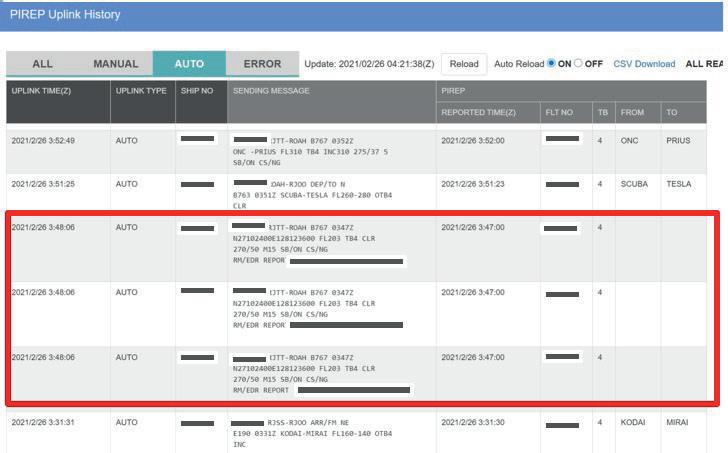
8 minute read
CASE STUDY: Better turbulence information for pilots at Japan Airlines (JAL
While all aircraft encounter some degree of turbulence on most flights, moderate turbulence can make movement around the cabin difficult. Severe turbulence can be more dangerous not so much to aircraft safety (they’re built to withstand it) but to passenger safety and comfort. In this light, any solution that can minimize aircraft exposure to turbulence, by helping pilots avoid the condition, will enhance passenger comfort and safety. With Weathernews, Japan Airlines has pioneered a system that goes a long way towards not only improving the information that pilots have about turbulence that might be on their flightpath but also ensuring that that information is received quickly in order to offer the maximum opportunity to avoid the turbulence or take mitigating action to ensure passenger safety.
Perhaps the best way to start this article is with a description of the overall solution (figure 1).
How to process PIREP using Machine Learning Algorithms (AI)
Example:
FL120-020 INC TB2O3 INSIGHT 500 AGL
Components of Jointly Development Solution
Figure 1
There are two main components in this new system. The first one is a solution developed by Japan Airlines. This is the first of its kind in Japan and it uses technology that automatically calculates turbulence indicators. The second component of this system is a machine learning algorithm developed by Weathernews. This algorithm processes the altitude of turbulence reported to the ground and then automatically notifies nearby aircraft in-flight. So, let us now look at those machine learning algorithms used to process turbulence information and send notifications automatically to aircraft (figure 2).
Figure 2
The system was put into operation in December 2020. Machine Learning (ML) technology records the turbulence information shared through the aircraft communication system.
After recording, the report is displayed on Japan Airlines’ Operation Management’s reporting system. Turbulence exceeding a certain threshold is automatically sent to aircraft flying within a specific range of the turbulence report position. The threshold and the range can be set by the user. Information such as aircraft position and observation time are included in the report. As a result, pilots will have a better understanding of the risk of turbulence that might affect their flight path.

INTERACTIVE Click here for full product details
Personalised WEATHER SUPPORT
INCREASE SAFETY & fuel efficiency AVOID COSTLY DIVERSIONS

Hourly forecast for destination airports Flight tracking w/ weather alerts
Learn more at weathernews.com
BENEFITS FOR JAPAN AIRLINES FROM USING THE NEW SYSTEM
First, we’ll explain the method used to automatically calculate turbulence indices using EDR (Eddy Dissipation Rate) data (figure 3).
Using machine learning to cope with ambiguous patterns (AI)
Before After
Regular Expression
EDR PIREP
Machine Learning
Regular Expression
Difficult to cover ambiguous patterns ->Error with only subtle changes ->After all, everyone checks and corrects. Machine learning for ambiguous patterns ->By using the reliability (probability), limit the rate at which someone checks
Figure 3
Traditionally, after encountering turbulence and ensuring the safety of passengers and crew, pilots report turbulence information to the ground through manual data communication or by ACARS or radio. As a result, there is a time lag between the time of the turbulence encounter and the time when the turbulence is reported to the ground.
Now, according to ICAO Annex 3, EDR or Eddy Dissipation Rate technology has become the new standard for reporting turbulence around the world. Japan


Airlines is the first airline in Japan to install an EDR calculation algorithm into aircraft computers. This algorithm converts the EDR value into turbulence information. Once processed, EDR information reported from the aircraft is reflected in real-time in Weathernews Operation Control support system ‘FOSTERNEXTGEN’. At Japan Airlines, pilots can consider safer flying operations by analyzing EDR information together with PIREP information on the same platform before departure.
Increased efficiency with this new system



We are pleased to report that Japan Airlines increased efficiency in their operations by using the new system. In the past Japan Airlines flight dispatchers would take turbulence reports from an aircraft that had encountered turbulence and share them with other aircraft in the vicinity. However, there was a time lag before the information reached pilots of the other aircraft. With this new solution, turbulence information can now be sent to aircraft automatically if a turbulence report exceeds a certain threshold. The aim is to quickly share turbulence information with aircraft in flight in order to minimize the risk for them of encountering turbulence.
In summary, by combining both systems in January 2021, the process from when an aircraft encounters and then reports turbulence to when other aircraft in the vicinity are notified has been completely automated (figure 5).
The System automatically sent EDR reports to other aircrafts under a minute
Observed 0347Z


Sent 0348Z
Figure 5
Also, the pilot of another aircraft in the vicinity who receives the notification can implement safety measures earlier, such as activating the sign to fasten seatbelts, initiate a change in the timing of in-flight meal provision or a change in flight altitude to avoid turbulence.
KOSUKE SAEKI
With a successful track record in delivering innovative weather solutions to large customers in Japan, Mr. Saeki is currently a service account manager at WNI’s SKY Planning department. He has also participated in joint IT development projects with JAL in the past three years.
FUMIYA HOMMA
Working with the Operation Safety and Quality Department, Japan Airlines, Mr. Homma is mainly in charge of weather-related work in the department. His main work is to set rules related to weather in the company, share weather information that affects operations, investigate and develop technologies related to weather, and coordinate with the Japan Meteorological Agency.
JAPAN AIRLINES (JAL)
Japan Airlines (JAL) is an international airline and Japan’s flag carrier, headquartered in Shinagawa, Tokyo. Group companies include Japan Airlines, J-Air, Japan Air Commuter, Japan Transocean Air, Ryukyu Air Commuter, Hokkaido Air System, and ZIPAIR Tokyo for domestic feeder services, plus JAL Cargo for cargo and mail services. The JAL fleets include more than 230 aircraft from all of the main OEMs.: Boeing, Airbus, Embraer, Bombardier, ATR and Saab.
WEATHERNEWS (WNI)
Weathernews Inc. collects weather data from various sources. They use their proprietary infrastructure to provide support where there is no or scarce weather information. The business supports flight dispatchers, operations members and pilots with a wide range of services during all phases of the flight, from planning to enroute and landing. Weathernews has more than 30 years of experience supporting and servicing airlines, and strives to learn each airline’s weather-related needs and challenges.
INTERACTIVE GIVE US YOUR OPINION
CLICK HERE TO POST YOUR COMMENT
INTERACTIVE SUBSCRIBE HERE
CLICK HERE TO READ ALL FUTURE EDITIONS
VENDOR FLIGHT LOG: LUFTHANSA SYSTEMS Lufthansa Systems shares how it works with customers to revolutionize scheduling and planning
Judith Semar has more than 20 years aviation experience, mainly focusing on commercial and operational topics. She is passionate about using modern technologies, automation, and optimization to manage airlines’ business processes. As the product owner for Schedule Optimization, she is now responsible for the NetLine optimization platform. As the current chair of the AGIFORS Scheduling and Strategic planning and past chair of the AGIFORS operation, she is well-known to many in the aviation industry
Aircraft IT: Your name, your job title and the name of the business?
Judith Semar: Judith Semar, Product Owner Schedule Optimization, Lufthansa Systems
Aircraft IT: How did the NetLine/HubDesigner get started?
JS: It started in 2018 with a completely different subject. We developed our NetLine vision and dealt with many future topics. In the course of this, we always put ourselves in the customers’ shoes. We soon realized that optimization would be one of the key focus areas for our customers in future years. As a result, the NetLine Optimizer Team was born. It deals exclusively with optimization topics; primarily in the network planning and scheduling environment, but also supporting our colleagues from the Operations Control and Crew division. Then, when the Covid-19 crisis hit, we quickly realized that the trend of the past few years, towards dynamic scheduling and network planning methods, had accelerated. At that time, we already worked closely with one of the largest airline groups in the world on the topic of network design and hub optimization. Since the pandemic drastically changed the market and competition environment for airlines, our customers need an optimizer building networks, hub structures and schedules from scratch based on the changed demand and supply situation. Of course, it significantly accelerated the entire development process.
Aircraft IT: What is the attraction of airline-related software?
JS: We live in a time when networks need to be adjusted or even redesigned more frequently, to a larger extent, and closer to departure day. Ultimately,




